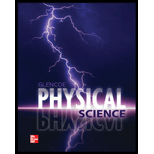
To explain: Process of detecting colors by human eye.
Answer to Problem 11R
Brain and human eye mutually translate a light into colour.
Explanation of Solution
Introduction:
Human eyes have three types of cone. Each of these cones responds to a different range of wavelengths.
Light enters the human eye (healthy) through a lens and also, is focused on retina (made-up of two light detecting cells). So, when the light enters eye (human) and hits the retina cone cells (one type of cell in retina) allows differentiating various colors. The cone cells send nerve impulse to the human brain, which interprets the different combinations of wavelengths as different colors.
Conclusion:
Human eyes can see different types of colour.
Chapter 12 Solutions
Glencoe Physical Science 2012 Student Edition (Glencoe Science) (McGraw-Hill Education)
Additional Science Textbook Solutions
Campbell Biology in Focus (2nd Edition)
Campbell Essential Biology (7th Edition)
Human Biology: Concepts and Current Issues (8th Edition)
Anatomy & Physiology (6th Edition)
Biology: Life on Earth with Physiology (11th Edition)
Introductory Chemistry (6th Edition)
- T1. Calculate what is the received frequency when the car drives away from the radar antenna at a speed v of a) 1 m/s ( = 3.6 km/h), b) 10 m/s ( = 36 km/h), c) 30 m /s ( = 108 km/h) . The radar transmission frequency f is 24.125 GHz = 24.125*10^9 Hz, about 24 GHz. Speed of light 2.998 *10^8 m/s.arrow_forwardNo Chatgpt please will upvotearrow_forwardNo Chatgpt please will upvotearrow_forward
- No Chatgpt pleasearrow_forward3. A measurement taken from the UW Jacobson Observatory (Latitude: 47.660503°, Longitude: -122.309424°, Altitude: 220.00 feet) when its local sidereal time is 120.00° makes the following observations of a space object (Based on Curtis Problems 5.12 + 5.13): Azimuth: 225.00° Azimuth rate: 2.0000°/s. Elevation: 75.000° Elevation rate: -0.5000°/s Range: 1500.0 km Range rate: -1.0000 km/s a. What are the r & v vectors (the state vector) in geocentric coordinates? (Answer r = [-2503.47 v = [17.298 4885.2 5.920 5577.6] -2.663]) b. Calculate the orbital elements of the satellite. (For your thoughts: what type of object would this be?) (Partial Answer e = 5.5876, 0=-13.74°) Tip: use Curtis algorithms 5.4 and 4.2.arrow_forwardConsider an isotope with an atomic number of (2(5+4)) and a mass number of (4(5+4)+2). Using the atomic masses given in the attached table, calculate the binding energy per nucleon for this isotope. Give your answer in MeV/nucleon and with 4 significant figures.arrow_forward
- A: VR= 2.4 cm (0.1 V/cm) = 0.24 V What do Vector B an C represent and what are their magnitudesarrow_forward4. Consider a cubesat that got deployed below the ISS and achieved a circular orbit of 410 km altitude with an inclination of 51.600°. What is the spacing, in kilometers, between successive ground tracks at the equator: a. Ignoring J2 (Earth's oblateness) effects b. Accounting for J2 effects c. Compare the two results and comment [Partial Answer: 35.7km difference]arrow_forwardplease solve and explainarrow_forward
 College PhysicsPhysicsISBN:9781305952300Author:Raymond A. Serway, Chris VuillePublisher:Cengage Learning
College PhysicsPhysicsISBN:9781305952300Author:Raymond A. Serway, Chris VuillePublisher:Cengage Learning University Physics (14th Edition)PhysicsISBN:9780133969290Author:Hugh D. Young, Roger A. FreedmanPublisher:PEARSON
University Physics (14th Edition)PhysicsISBN:9780133969290Author:Hugh D. Young, Roger A. FreedmanPublisher:PEARSON Introduction To Quantum MechanicsPhysicsISBN:9781107189638Author:Griffiths, David J., Schroeter, Darrell F.Publisher:Cambridge University Press
Introduction To Quantum MechanicsPhysicsISBN:9781107189638Author:Griffiths, David J., Schroeter, Darrell F.Publisher:Cambridge University Press Physics for Scientists and EngineersPhysicsISBN:9781337553278Author:Raymond A. Serway, John W. JewettPublisher:Cengage Learning
Physics for Scientists and EngineersPhysicsISBN:9781337553278Author:Raymond A. Serway, John W. JewettPublisher:Cengage Learning Lecture- Tutorials for Introductory AstronomyPhysicsISBN:9780321820464Author:Edward E. Prather, Tim P. Slater, Jeff P. Adams, Gina BrissendenPublisher:Addison-Wesley
Lecture- Tutorials for Introductory AstronomyPhysicsISBN:9780321820464Author:Edward E. Prather, Tim P. Slater, Jeff P. Adams, Gina BrissendenPublisher:Addison-Wesley College Physics: A Strategic Approach (4th Editio...PhysicsISBN:9780134609034Author:Randall D. Knight (Professor Emeritus), Brian Jones, Stuart FieldPublisher:PEARSON
College Physics: A Strategic Approach (4th Editio...PhysicsISBN:9780134609034Author:Randall D. Knight (Professor Emeritus), Brian Jones, Stuart FieldPublisher:PEARSON





